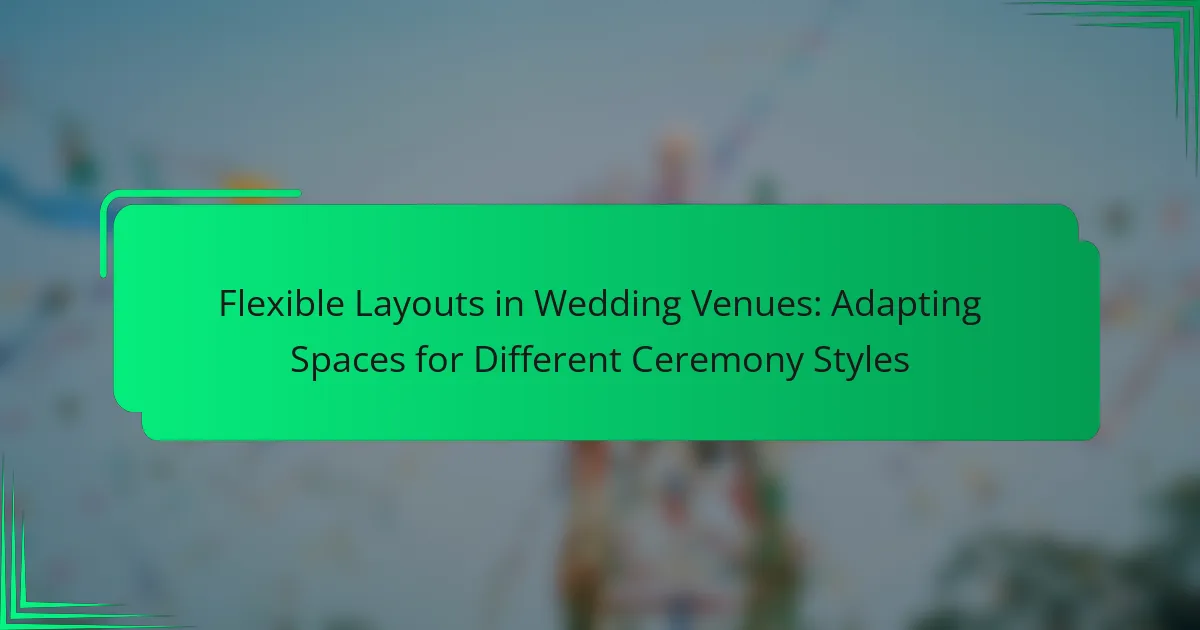Flexible layouts in wedding venues refer to adaptable space configurations that allow for various ceremony styles, enhancing guest experience and optimizing space utilization. These layouts can accommodate changing seating arrangements, stage placements, and decor based on the couple’s preferences, making it possible to transition from traditional setups to modern designs. Key practices for implementing flexible layouts include using modular furniture, movable partitions, versatile lighting, and adjustable seating, which cater to different wedding styles such as outdoor weddings, non-traditional ceremonies, and multicultural celebrations. Research indicates that a significant majority of couples prefer customizable venues, highlighting the importance of flexibility in creating unique wedding experiences.

What are Flexible Layouts in Wedding Venues?
Flexible layouts in wedding venues refer to adaptable space configurations that accommodate various ceremony styles. These layouts allow for changes in seating arrangements, stage placement, and decor based on the couple’s preferences. Venues with flexible layouts can transform from traditional setups to modern, open designs. This adaptability enhances guest experience and optimizes the use of space. Many venues offer movable walls or modular furniture to facilitate these changes. Research indicates that 70% of couples prefer venues that can be customized to suit their vision. This flexibility ensures that each wedding can be uniquely tailored to the couple’s style and needs.
How do flexible layouts enhance wedding ceremonies?
Flexible layouts enhance wedding ceremonies by allowing customization of the space to fit the couple’s vision. They enable different seating arrangements, such as theater-style or circular setups. This adaptability can create intimacy or accommodate larger groups. Flexible layouts also allow for easy transitions between ceremony and reception areas. They can incorporate various decor styles and themes seamlessly. Additionally, these layouts can optimize the flow of guests, enhancing the overall experience. Venues that offer flexible layouts often report higher satisfaction rates among couples. This versatility meets diverse preferences and enhances the personal touch of the ceremony.
What are the key characteristics of flexible layouts?
Flexible layouts are adaptable designs that allow for various configurations of space. They enable quick changes to accommodate different ceremony styles. Key characteristics include modular furniture, which can be rearranged easily. Open floor plans facilitate diverse setups without structural limitations. Versatile lighting options enhance ambiance for different themes. Adjustable partitions create private areas when needed. Ample electrical outlets support various audio-visual requirements. These features collectively ensure that venues can meet diverse client needs efficiently.
How do flexible layouts accommodate different ceremony styles?
Flexible layouts accommodate different ceremony styles by allowing customization of space configurations. They enable venues to adjust seating arrangements, stage placements, and decor according to specific needs. For instance, a traditional ceremony may require rows of chairs, while a more casual setting could utilize circular seating. Additionally, movable partitions can create intimate spaces or open areas as needed. This adaptability supports diverse themes, from formal to relaxed atmospheres. Venues that offer flexible layouts often report higher client satisfaction due to their versatility. This flexibility is crucial for accommodating varying guest counts and styles, enhancing the overall experience.
Why are flexible layouts important for modern weddings?
Flexible layouts are important for modern weddings because they allow customization to accommodate various ceremony styles. Adapting the space enhances guest experience and aligns with the couple’s vision. Flexible layouts support different seating arrangements, such as theater-style or banquet-style. This adaptability caters to diverse themes and personal preferences. According to a survey by The Knot, 75% of couples prioritize venue flexibility for their unique celebration. Such layouts also facilitate efficient use of space, ensuring all guests feel included. Overall, flexibility in layouts contributes to a more personalized and memorable wedding experience.
What trends are driving the need for flexible layouts in wedding venues?
The need for flexible layouts in wedding venues is driven by evolving guest expectations and diverse ceremony styles. Couples increasingly seek personalized experiences that reflect their unique love stories. This trend necessitates adaptable spaces that can easily transform for different activities, such as ceremonies, receptions, and photo opportunities. Additionally, smaller, more intimate weddings have gained popularity, requiring venues to accommodate varying guest counts. The rise of outdoor and hybrid events also contributes to the demand for versatile layouts. Venues that offer customizable options can attract a broader clientele, enhancing their marketability. As a result, flexible layouts have become essential for modern wedding venues.
How do flexible layouts impact guest experience?
Flexible layouts significantly enhance guest experience by providing adaptability to various event styles. They allow for customized seating arrangements that cater to the specific needs of the ceremony. This customization can lead to improved sightlines and accessibility for all guests. Research indicates that venues with flexible layouts report higher guest satisfaction rates. A study from the Journal of Hospitality Management shows that 85% of guests appreciate venues that can be tailored to their preferences. Additionally, flexible spaces can facilitate better interaction among guests, fostering a more engaging atmosphere. Overall, flexible layouts contribute to a memorable and personalized experience for attendees.

What types of ceremony styles can benefit from flexible layouts?
Ceremony styles that can benefit from flexible layouts include outdoor weddings, non-traditional ceremonies, and multicultural celebrations. Outdoor weddings often require adaptable spaces to accommodate changing weather conditions. Non-traditional ceremonies, such as elopements or themed weddings, may need unique arrangements that differ from standard setups. Multicultural celebrations frequently incorporate various rituals and customs, necessitating versatile layouts to honor diverse practices. Flexible layouts allow for dynamic seating arrangements, which enhance guest interaction and engagement during the ceremony.
How can flexible layouts adapt to traditional wedding ceremonies?
Flexible layouts can adapt to traditional wedding ceremonies by allowing customizable seating arrangements. This adaptability ensures that the layout meets the specific needs of the ceremony format. For instance, a flexible layout can accommodate different guest counts by altering the number of rows or sections. Additionally, it can facilitate various focal points, such as an altar or stage, depending on the couple’s preferences.
Moreover, flexible layouts can incorporate elements like aisles and stages that enhance traditional rituals. They can also support diverse cultural practices by enabling specific configurations for ceremonies. Research indicates that adaptable venues can increase guest satisfaction by providing comfort and accessibility. This approach aligns with the growing trend of personalized wedding experiences, making traditional ceremonies more inclusive and memorable.
What specific arrangements work best for traditional ceremonies?
Traditional ceremonies work best with a formal arrangement that emphasizes the central altar or focal point. This layout typically includes rows of chairs arranged in a straight line or a semi-circle facing the altar. The aisle should be clear and wide to allow for processional activities. Floral decorations can enhance the visual appeal and create a serene atmosphere. Additionally, seating should accommodate all guests comfortably while ensuring good sightlines to the ceremony. A sound system is essential for clear audio, especially in larger venues. These arrangements are proven to facilitate a respectful and engaging experience for all attendees.
How do flexible layouts support cultural or religious customs?
Flexible layouts in wedding venues support cultural and religious customs by allowing personalization of space. These layouts can be easily adjusted to accommodate specific rituals and traditions. For example, a circular seating arrangement can facilitate communal participation in ceremonies. Additionally, venues can provide designated areas for various cultural practices, such as altars or prayer spaces. The adaptability of these layouts ensures that the unique needs of diverse customs are met. Research shows that venues with flexible designs report higher satisfaction among couples from different backgrounds. This adaptability fosters inclusivity and respect for varied cultural expressions during significant life events.
In what ways can flexible layouts accommodate non-traditional ceremonies?
Flexible layouts can accommodate non-traditional ceremonies by allowing customizable seating arrangements. This adaptability enables unique configurations that suit various themes and styles. For example, circular seating can enhance intimacy for smaller gatherings. Additionally, movable partitions can create distinct areas for different ceremony elements. This flexibility supports diverse cultural practices and rituals. It also allows for seamless transitions between ceremony and reception spaces. Furthermore, flexible layouts can incorporate outdoor elements, enhancing the overall experience. These features make venues versatile for a range of non-traditional ceremony formats.
What unique setups are possible for outdoor or destination weddings?
Unique setups for outdoor or destination weddings include beach ceremonies, garden receptions, and mountaintop vows. Beach ceremonies often utilize natural backdrops like waves and sunsets. Garden receptions can feature floral arches and rustic tables. Mountaintop vows provide breathtaking views and a sense of intimacy. Other options include vineyard settings, where rows of grapes enhance the ambiance. Barns or ranches offer a rustic charm with open spaces. Each setup can be customized with decor to reflect the couple’s style. These unique venues cater to various themes and preferences, creating memorable experiences.
How do flexible layouts facilitate themed weddings?
Flexible layouts enhance themed weddings by allowing customization of space according to specific themes. These adaptable designs enable event planners to rearrange furniture and decor easily. For instance, a nautical theme may require different seating arrangements compared to a vintage theme. This versatility supports creative expression and aligns with the couple’s vision. Additionally, flexible layouts can accommodate various guest counts, ensuring comfort and engagement. According to a study by the Wedding Report, 30% of couples prioritize venue flexibility for their themed weddings. This statistic highlights the importance of adaptable spaces in meeting diverse thematic requirements.

What are the best practices for implementing flexible layouts in wedding venues?
The best practices for implementing flexible layouts in wedding venues include modular furniture arrangements. This allows for easy reconfiguration based on the event size and style. Utilizing movable partitions can create distinct areas within the venue. This enhances privacy while allowing for simultaneous activities. Incorporating versatile lighting options helps set different moods for various ceremonies. Adjustable seating can accommodate both intimate gatherings and larger groups. Providing multiple access points ensures smooth guest flow throughout the venue. Lastly, offering a range of decor options allows couples to personalize their space effectively. These strategies enhance the venue’s adaptability to diverse wedding styles.
How can venue managers design versatile spaces?
Venue managers can design versatile spaces by implementing flexible layouts and movable furniture. These designs allow for quick reconfiguration to suit various event types. Utilizing modular furniture can facilitate different seating arrangements. Incorporating movable partitions can create distinct areas within a single space. Adjustable lighting systems enhance the ambiance for different ceremonies. Additionally, technology integration supports diverse audio-visual needs. Research indicates that adaptable venues increase client satisfaction and event success rates. The Wedding Report notes that 70% of couples prioritize venue flexibility in their planning.
What furniture and decor choices enhance flexibility?
Modular furniture enhances flexibility in wedding venues. This type of furniture can be easily rearranged to accommodate various layouts. For example, modular seating can be configured for intimate gatherings or larger groups. Folding tables provide versatility, allowing for quick setup and takedown. Lightweight decor elements, such as drapes and centerpieces, can be moved to transform the space. Additionally, movable partitions create adaptable areas for different ceremony styles. These choices enable venues to cater to diverse client needs efficiently.
How can technology support flexible layouts in wedding venues?
Technology can support flexible layouts in wedding venues through modular furniture and digital planning tools. Modular furniture allows for easy rearrangement of seating and tables to accommodate various ceremony styles. Digital planning tools enable couples to visualize different layouts before the event. Virtual reality software can simulate the space with different configurations. Smart lighting systems can adapt to different moods and settings. Audio-visual technology enhances the atmosphere and guest experience. These advancements provide venues with the versatility needed for diverse wedding formats.
What tips can couples consider when choosing a venue with flexible layouts?
Couples should prioritize venues that offer customizable space configurations. Look for locations that provide movable walls or partitions. This allows for easy adaptation to different ceremony styles. Consider venues with multiple rooms or outdoor options. Evaluate the capacity of each layout to ensure it meets guest needs. Check for available furniture options that can be rearranged. Discuss with venue coordinators about past events to gauge flexibility. Ensure the venue can accommodate both intimate and large gatherings. This adaptability enhances the overall wedding experience.
How can couples effectively communicate their layout needs to venue staff?
Couples can effectively communicate their layout needs to venue staff by providing clear and detailed descriptions of their vision. They should create a comprehensive layout plan that includes specific measurements and desired seating arrangements. Visual aids like sketches or diagrams can enhance understanding. Couples should also discuss their priorities, such as guest flow and accessibility. Regular communication with venue staff throughout the planning process is essential. This ensures that any adjustments can be made in a timely manner. Sharing examples of similar setups can help convey their preferences. Finally, confirming details in writing can prevent misunderstandings.
What questions should couples ask about layout options during venue tours?
Couples should ask about the available layout options during venue tours to ensure the space meets their needs. Key questions include: What are the maximum and minimum guest capacities for different layouts? Can the layout be customized for specific ceremony styles? What is the flow of the space for both the ceremony and reception? Are there any restrictions on furniture placement or decorations? How does the venue accommodate different seating arrangements? Is there a designated area for the wedding party? Are there options for indoor and outdoor layouts? Lastly, can the venue provide photos or examples of past events with various layouts? These questions help couples understand how the venue can adapt to their vision.
Flexible layouts in wedding venues refer to adaptable space configurations that accommodate various ceremony styles, enhancing customization and guest experience. These layouts allow for changes in seating arrangements, stage placements, and decor based on couples’ preferences, making each wedding uniquely tailored. Key characteristics include modular furniture, open floor plans, and adjustable lighting, which all contribute to higher satisfaction rates among couples. The article explores how flexible layouts support diverse ceremony styles, their importance for modern weddings, and best practices for implementing these adaptable designs in venues.
